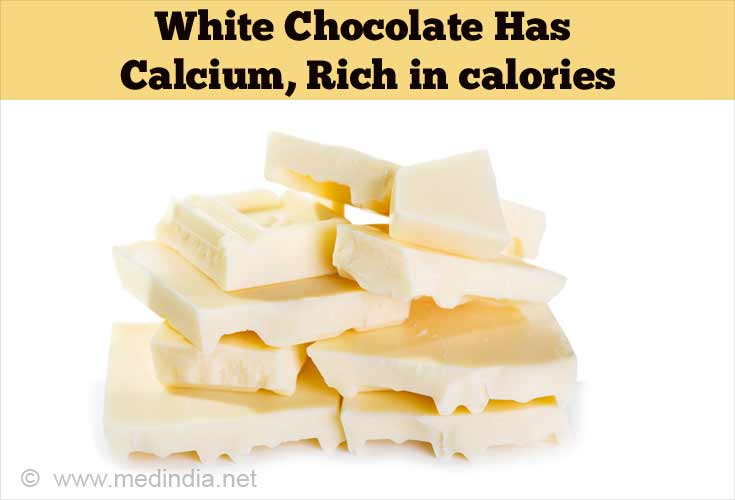- 11 FACTS ABOUT CHOCOLATE - (https://beta.dosomething.org/facts/11-facts-about-chocolate)
- Can chocolate be good for m health? - (http://www.mayoclinic.org/healthy-living/nutrition-and-healthy-eating/expert-answers/healthy-chocolate/faq-20058044)
Facts on Different Kinds of Chocolate
Life is like a box of chocolates; you never know what is in store for you. And what you find could actually surprise you - sweet, delectable and oh so satisfying!! Just like the phases of life, some chocolates are crunchy, some nutty, some dark, some white, but no matter what, they are all delicious.
So if money ‘talks’, then chocolate surely ‘sings’; you will agree to that if you are a ‘chocolatarian’. After all you can’t buy happiness, but you can buy something, which is ground from the beans of happiness to put a smile on your face - CHOCOLATE! Whether you are feeling depressed, lonely or under the weather, sometimes the only prescription you need is more chocolate. It flows like a river to ignite your mind and your senses.

Most of us are health conscious and feel guilty when indulging in any tasty chocolatey delight, but what you may or may not know is that the cocoa bean from which chocolate is made actually has some health benefits. Of course, moderation is the key, as anything in excess could lead to weight gain. The different types of chocolate have different nutritional values. And not to forget that just like red wine, chocolate is also a rich source of bio-flavonoids. The antioxidants and flavonoids in chocolate have been known to lower the risk of cancer and help in regulating cholesterol levels.
Many chocolate making companies such as Hershey, Ghirardelli, Mars, Russell Stover and Cadbury, have enjoyed phenomenal success through the manufacture and marketing of their numerous chocolate products. Chocolate is one of the key ingredients when it comes to baking and the familiarity with different types of chocolate helps you master the art of baking.
How is Chocolate Made?
Chocolate is primarily made from cocoa bean, which grows on cocoa trees in Central and South America, as well as in parts of the Caribbean and Africa. Cocoa bean in its untreated form is extremely bitter; hence it has to be treated to make it palatable. The best cocoa beans are selected and many different varieties are carefully blended to achieve that deep, rich flavor of chocolate. The cocoa beans are first roasted at high temperatures to develop the chocolate flavor, then they are shelled and the remaining nibs are liquefied into a thick liquid called chocolate liquor which contain only the chocolate solids and the rich, creamy cocoa butter. The way the cocoa beans are treated also affects its nutritional value; it is seen that the closer the final chocolate product is to the original cocoa bean, the higher is its nutritional value! Powdered cocoa is also widely used and can have a high nutritional profile if it is used without cream, full fat milk or lot of sugar.
Meet the Chocolate Family
Chocolates come in different types based on different combinations of the cocoa solids and cocoa butter with other ingredients:
Dark Chocolate
Amongst all types of chocolate, dark chocolate has the highest percentage of cocoa solids and cocoa butter along with other ingredients such as sugar and cocoa bean powder. Studies have shown that it could help blood flow more freely to areas of the brain, thus helping people with dementia and is the healthiest of all the three types of chocolate. It is slightly lower in saturated fats and cholesterol as compared to other chocolates. Dark chocolate contains a minimum of 70% cocoa as compared to a maximum of 35% in white chocolate. The different forms of dark chocolate are sweet, semi-sweet, bittersweet or unsweetened. Antioxidants, which are abundant in dark chocolate, have the potential to lower inflammation and enhance cardiovascular health. It's a well-liked option for anyone seeking to indulge in a healthier treat because it has less sugar than milk chocolate. Essential minerals, which include copper, iron, manganese, magnesium, and zinc, are necessary for a number of biological processes and add to dark chocolate's allure as a "better for you" confection.

Bitter Sweet Chocolate: It is a dark sweetened chocolate which usually contains 60% to 85% cocoa solids depending on the brand. Generally, if the content of cocoa solids is high the sugar content is low leading to rich, intense, bitter chocolate flavor. It is often used in baking/cooking and should not be substituted with semi-sweet or sweet chocolate if the recipe calls for it.
Milk Chocolate
Milk chocolate, which is most often eaten in the form of a candy bar, was first invented by Swiss candy-maker Daniel Peter in 1876; he was the one who devised the process of adding condensed milk to chocolate. Milk chocolate typically contains milk powder, sugar and a small amount of cocoa solids and cocoa butter. The typical rich, creamy taste in milk chocolate comes from the milk powder and lesser quantity of cocoa. Due to higher milk content in this variety, there is little bit more calcium and protein in milk chocolate as compared to dark chocolate. It has slightly more dairy fat and calorie content as compared to dark chocolate, but barely noticeable.
People could only consume milk chocolate as a liquid beverage, before it was available in solid form. Condensed milk or milk powder, which is made by evaporating milk until only a powdered substance remains, has enabled people to create milk chocolate in solid bars because powdered milk has a far longer stability and shelf life than its liquid counterpart.
White Chocolate
The name ‘white chocolate’ is misleading because it does not really contain chocolate or cocoa solids most of the times. In some places, white chocolate cannot be called "chocolate" because it has low content of cocoa solids. It has only sugar, milk and a small quantity of cocoa butter, which gives it the creamy and chocolatey appearance. Thus the benefits of cocoa do not apply to this. Dark chocolate contains a minimum of 70% cocoa versus a maximum of 35% in white chocolate. Dark chocolate melts easier than white chocolate at room temperature. The nutritional profile of white chocolate is the lowest as compared to other chocolates. It has a mild and pleasant flavor and can be used to make desserts such as chocolate mousse, panna cotta etc.

Benefits of Dark, Milk and White Chocolates
Any chocolate, whether dark chocolate, white chocolate or milk chocolate, should be consumed wisely and in the right amount, as we know the after effects of consuming too much. They could be very addictive, but you should have the discretion to eat wisely in order to stay healthy.
Studies conducted so far have shown that eating dark chocolate is beneficial for the health. It contains high level of antioxidants which help remove toxins that is known to cause various diseases. Dark chocolate is rich in substances such as epicatechin and gallic acids which protect the heart from heart attacks. Dark chocolate is also a brain stimulator, cough preventer and has antidiarrheal effects apart from its anticancer properties.
White chocolate, on the other hand, is the wrong choice, if you are trying to lose weight. On one hand it is quite rich in calories, but the positive aspect is that it contains a bit of calcium. However, it is the least nutritious of the three types of chocolate as it does not contain cocoa solids.
Compared to white chocolate, the nutritional profile of milk chocolate is higher due to the small presence of cocoa in it, but is still not very high so as to be considered as having positive effects on your health.
Which has more health benefits - dark, milk or white chocolate?
The primary health benefit of chocolate comes from cocoa, which is packed with healthy chemicals like flavonoids and theobromine. No doubt then cocoa or the “little bean” is known as a “disease-killing bullet”.
- Weight loss: Some reports suggest that dark chocolate is better for weight loss since it contains significantly less carbohydrates. People trying to lose weight try to follow a low-carb diet. Studies have shown that a high carbohydrate meal will increase insulin secretion, which is a sign for the body to store energy as fat. Typically milk chocolate usually has about 50 grams of carbs in a 100g bar, whereas the amount of carbs in dark chocolate range from 8 to 35 carbs, depending on how dark it is. Dark chocolate also has comparatively more good fats like stearic acid, which is known to have neutral effects on low density lipoprotein (LDL).

- Blood pressure: Studies have shown that cocoa consumption improves arterial flow in smokers. Literature also indicates that dark chocolate consumption lowers blood pressure as demonstrated by few studies. In one of the studies, it was seen that endothelial function was improved by the consumption of flavanol-rich dark chocolate while another study showed that though dark chocolate did not reduce blood pressure or reduce oxidative stress, it improved coronary circulation.
- Cardiovascular disease: Few studies have shown that in humans, both with normal and elevated cholesterol levels, eating cocoa powder mixed with hot water reportedly lowers oxidized LDL and ApoB. Another study showed that chocolate consumption was inversely associated with progression of atherosclerotic plaque and cardiovascular disease in general.
- Diabetes prevention: An Italian study showed that participants who ate a candy bar's worth of dark chocolate once a day for 15 days saw their potential for insulin resistance reduced by nearly half. The theory behind this is that flavonoids increase nitric oxide production and thus help to control insulin sensitivity.
- Stress buster: Stress is known to release cortisol, which could have detrimental effects on your body. In a Swiss study, the scientists found that people with lot of anxiety/stress, who ate an ounce and a half of dark chocolate every day for two weeks, their stress hormone levels were significantly lowered and the metabolic effects of stress were partially mitigated.

Recipe with Dark, Milk and White Chocolates
Layered Chocolate Mousse
For the dark and milk chocolate mousse
- 175 g dark chocolate, chopped
- 175 g milk chocolate, chopped
- 1 orange
- Splash of milk
- 2 egg yolks
- 8 egg whites
- 50 g castor sugar
For the white chocolate mousse
- 175 g chopped white chocolate
- 175 ml double cream
- 1 egg white
Garnishing
- Grated chocolate
- Grated orange rind
Method
- Put dark chocolate into a large glass bowl and set it over a pan of simmering water. Heat till it just melts and add a splash of milk and mix well. Remove from heat. After it slightly cools add in one beaten egg yolk
- Repeat same procedure with milk chocolate in separate bowl, adding splash of milk and remaining egg yolk when slightly cool. Add grated rind from half an orange and add into above mixture
- Take the egg whites and whisk them till they form soft peaks and then add the sugar and whisk again.
- Take a quarter of the egg white mixture and whisk it into each chocolate mixture.
- Fold in the remaining egg white equally between the two chocolate mixtures.
- To prepare white chocolate mousse, melt the chocolate as specified above and allow it to cool a little. Whisk cream and egg whites separately and add both of them into the above chocolate mixture.
- Take glass goblets and layer-up chocolate mousse mixtures starting with white chocolate, then milk chocolate and then the dark chocolate mousse.
- Refrigerate for one hour or so till firm.
- Garnish with grated chocolate and orange rind.
You can reap benefits from eating small amounts of chocolate, so snack smart, try to pick healthy chocolate with at least 70 percent cocoa. Chocolate's reputation is now on the rise, as a growing number of studies indicate that it can be a healthy choice.







